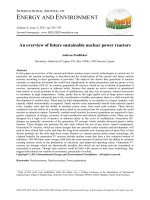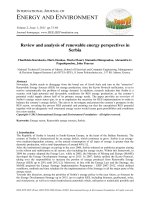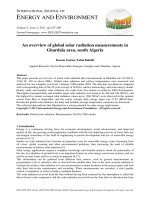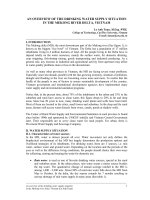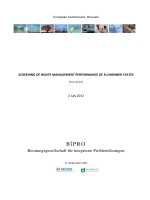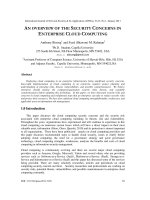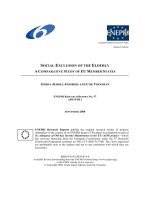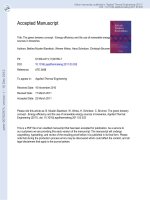An overview of the EU Member States support schemes for the promotion of renewable energy sources
Bạn đang xem bản rút gọn của tài liệu. Xem và tải ngay bản đầy đủ của tài liệu tại đây (308.93 KB, 14 trang )
INTERNATIONAL JOURNAL OF
ENERGY AND ENVIRONMENT
Volume 3, Issue 4, 2012 pp.553-566
Journal homepage: www.IJEE.IEEFoundation.org
An overview of the EU Member States support schemes for
the promotion of renewable energy sources
Andreas Poullikkas, George Kourtis, Ioannis Hadjipaschalis
Electricity Authority of Cyprus, P.O. Box 24506, 1399 Nicosia, Cyprus.
Abstract
In this work, an overview of the European Union (EU) Member States support schemes for the
promotion of renewable energy sources (RES) is provided. In particular, the status of the electricity
generation capacity as well as the RES mixture in the Member States is described. Moreover, the
different support schemes such as, investment support, feed-in tariffs (FiTs), tradable green certificates,
and fiscal and financial measures which the Member States have adopted for the promotion of RES
technologies are discussed in detail. Some Member States are implementing a single support scheme for
the promotion of RES for power generation (RES-E), e.g., seven Member States use FiTs, or implement
a hybrid support scheme by combining all or some of the four categories of the RES-E supporting
schemes. Although, these support schemes have increased the penetration of the RES-E technologies in
the Member States, still there is a long way in order to achieve the 2020 target. The reason for this may
be that the way these schemes have been used so far, i.e., either as single support schemes or in
combination of FiTs or tradable green certificates with investment support and fiscal and financial
measures, has been ineffective. A more effective combination could be a hybrid scheme consisting of
FiTs with tradable green certificates measures, as in the case of Italy and United Kingdom, that will
increase the RES-E penetration and eliminate the possible technical problems which will arise from this
increased penetration and have an effect in the stability of the power system.
Copyright © 2012 International Energy and Environment Foundation – All rights reserved.
Keywords: RES directive; Feed-in tariffs; Green certificates; Renewable energy sources.
1. Introduction
The European Union (EU) has already tuned its energy policy into achieving maximum carbon dioxide
(CO2) emissions reduction from power generation plants. In this context, it has already set out a strategic
objective of achieving at least a 20% reduction of greenhouse gases by 2020 compared to 1990 levels
[4]. This strategic objective represents the core of the new European energy policy. Recognizing the
positive effects of renewable energy sources (RES) technologies towards achieving this goal, the EU has
taken a range of specific actions in the direction of enhancing the integration of RES in the existing
European power generation system as a major step towards the reduction of global warming and climate
change phenomena.
Specifically, an action plan in the form of an EU Directive on the promotion of the use of energy from
RES [3] has been introduced by the EU whereby a target of RES share of 20% out of the gross final
energy consumption of the EU has been set to be reached by the year 2020. According to this Directive
[3], different supporting schemes can be used by the Member States for the promotion of RES
ISSN 2076-2895 (Print), ISSN 2076-2909 (Online) ©2012 International Energy & Environment Foundation. All rights reserved.
554
International Journal of Energy and Environment (IJEE), Volume 3, Issue 4, 2012, pp.553-566
technologies, either by the implementation of a single support scheme or by the implementation of a
hybrid combination of two or more support schemes.
The purpose of this work is to provide an overview of the EU Member States support schemes for the
promotion of RES. In particular, the current status of the electricity generation capacity as well as the
RES mixture in the Member States is described. Moreover, the different support schemes such as,
investment support, feed-in tariffs (FiTs), tradable green certificates, and fiscal and financial measures
which the Member States have adopted for the promotion of RES technologies are discussed in detail.
In section 2, a brief description of the EU RES Directive is provided. The status of the current electricity
generation capacity in the Member States is provided in section 3, whereas the different EU Member
States support schemes for the promotion of RES technologies are described in section 4. Finally, the
conclusions are summarized in section 5.
2. The EU RES directive
The EU policy on RES is set out in the relevant Directive [3] of the European parliament and of the
Council. The Directive concerns the promotion and use of energy from RES and establishes a common
framework for the promotion of energy from RES. It sets mandatory national targets for each Member
State for the overall share of energy from RES in gross final consumption of energy and for the share of
energy from RES in transport. Also, it lays down rules relating to statistical transfers between Member
States, joint projects between Member States and with third countries, guarantees of origin,
administrative procedures, information and training, and access to the electricity grid for energy from
RES.
Table 1. EU member states RES targets for 2020
Member State
Austria
Belgium
Bulgaria
Cyprus
Czech Republic
Denmark
Estonia
Finland
France
Germany
Greece
Hungary
Ireland
Italy
Latvia
Lithuania
Luxembourg
Malta
Netherlands
Poland
Portugal
Romania
Slovak Republic
Slovenia
Spain
Sweden
United Kingdom
Share of energy from renewable
sources in gross final consumption
of energy, 2005 (S2005) [%]
23.3
2.2
9.4
2.9
6.1
17.0
18.0
28.5
10.3
5.8
6.9
4.3
3.1
5.2
32.6
15.0
0.9
0.0
2.4
7.2
20.5
17.8
6.7
16.0
8.7
39.8
1.3
Target for share of energy from
renewable sources in gross final
consumption of energy, 2020 (S2020) [%]
34
13
16
13
13
30
25
38
23
18
18
13
16
17
40
23
11
10
14
15
31
24
14
25
20
49
15
ISSN 2076-2895 (Print), ISSN 2076-2909 (Online) ©2012 International Energy & Environment Foundation. All rights reserved.
International Journal of Energy and Environment (IJEE), Volume 3, Issue 4, 2012, pp.553-566
555
Based on the Directive, each Member State shall ensure that the share of energy from RES, calculated in
accordance with specific EU guidelines, in gross final consumption of energy in 2020 is at least its
national overall target for the share of energy from RES in that year, as set out in Table 1. Such
mandatory national overall targets are consistent with a target of at least a 20% share of energy from RES
in the Community’s gross final consumption of energy in 2020. In order to achieve the national targets,
each Member State is encouraged to promote energy efficiency and energy saving. In addition, Member
States are required to introduce measures effectively designed to ensure that the share of energy from
RES for each year leading up to the year 2020, equals or exceeds a pre-specified indicative trajectory set
out in the RES Directive for each individual Member State, as shown in Table 2. Finally, each Member
State shall ensure that the share of energy from RES in all forms of transport in 2020 is at least 10 % of
the final consumption of energy in transport in that Member State.
Table 2. EU Member States RES countries indicative trajectory up to 2020
Indicative trajectory
Notes
S2005 + 0.2 (S2020-S2005)
As an average for the two year period 2011 to 2012
S2005 + 0.3 (S2020-S2005)
As an average for the two year period 2013 to 2014
S2005 + 0.45 (S2020-S2005)
As an average for the two year period 2015 to 2016
S2005 + 0.65 (S2020-S2005)
As an average for the two year period 2017 to 2018
S2005= The share for that EU country in 2005 as indicated in Table 1
S2020= The share for that EU country in 2020 as indicated in Table 1
The gross final consumption of energy from RES in each Member State is calculated as the sum of (a)
the gross final consumption of electricity from RES, (b) the gross final consumption of energy from RES
for heating and cooling and (c) the final consumption of energy from RES in transport. The share of
energy from RES is calculated as the gross final consumption of energy from RES divided by the gross
final consumption of energy from all energy sources, expressed as a percentage.
In order to reach the targets set in Table 1, each Member State may apply financial support schemes for
facilitating the domestic production of RES or, in case a Member State cannot fully achieve the targets
by relying on domestic renewable production, it may opt for any of the four types of measures of
cooperation between different Member States and/or third countries. The four types of measures are the
(a) statistical transfers between Member States, (b) joint projects between Member States, (c) joint
projects between Member States and third countries and (d) joint support schemes.
In the statistical transfers between Member States measure, Member States may agree and make
arrangements for the statistical transfer of a specified amount of energy from RES from one Member
State (which expects to have a surplus of generated renewable energy) to another Member State (which
expects to have a deficit). The transferred quantity shall be deducted from the country making the
transfer and added to the country accepting the transfer. In the joint projects between Member States
measure, two or more Member States may cooperate on all types of joint projects relating to the
production of electricity, heating or cooling from RES. That cooperation may involve private operators.
Effectively, the renewable energy produced by a joint project in the territory of one Member State can be
agreed to count towards the national overall target of another Member State. The joint projects between
Member States and third countries measure, is very similar to the joint projects between Member States
measure, but it refers only to the production of electricity from RES. The renewable electricity produced
can count towards the national target of the Member State, under the condition that the produced
electricity is consumed in the European Community. In the joint support schemes measure, two or more
Member States may decide, on a voluntary basis, to join or partly coordinate their national support
schemes. In such cases, a certain amount of energy from RES produced in the territory of one
participating Member State may count towards the national overall target of another participating
Member State.
As part of the national policies and measures for the promotion of RES, according to the EU RES policy,
Member States must ensure that transmission system operators and distribution system operators in their
territory guarantee the transmission and distribution of electricity produced from RES. For this purpose,
Member States must arrange for either priority access or guaranteed access to the electricity grid for
electricity produced from RES.
ISSN 2076-2895 (Print), ISSN 2076-2909 (Online) ©2012 International Energy & Environment Foundation. All rights reserved.
556
International Journal of Energy and Environment (IJEE), Volume 3, Issue 4, 2012, pp.553-566
In addition, Member States must ensure that the origin of electricity produced from RES can be
guaranteed in accordance with objective, transparent and non-discriminatory criteria. To that end,
Member States must ensure that a guarantee of origin is issued in response to a request from a producer
of electricity from RES. Member States may arrange for guarantees of origin to be issued in response to a
request from producers of heating and cooling from RES. Such an arrangement may be made subject to a
minimum capacity limit. A guarantee of origin shall be of the standard size of 1MWh. No more than one
guarantee of origin shall be issued in respect of each unit of energy produced.
In line with the EU RES policy, each Member State already adopted a national RES action plan. The
national RES action plans set out Member States’ national targets for the share of energy from RES
consumed in transport, electricity and heating and cooling in 2020, taking into account the effects of
other policy measures relating to energy efficiency on final consumption of energy, and adequate
measures to be taken to achieve those national overall targets.
The national RES action plans were submitted to the Commission on the 30th June 2010. In addition,
each Member State published and notified to the Commission, six months before its national RES action
plan was due, a forecast document indicating (a) its estimated excess production of energy from RES
compared to the indicative trajectory which could be transferred to other Member States, as well as its
estimated potential for joint projects, until 2020 and (b) its estimated demand for energy from RES to be
satisfied by means other than domestic production until 2020. The individual country data resulting from
the forecast documents are shown in Table 3. Based on this data, the proposed measures of cooperation
between Member States are likely to be activated since some countries expect to have excess amount of
RES energy generated while some others expect to have deficits of RES energy. Finally, each Member
State shall submit a report to the Commission on its progress in the promotion and use of energy from
RES by 31 December 2011, and every two years thereafter. The sixth report, to be submitted by 31
December 2021, shall be the last report required.
Table 3. EU Member States forecast for national RES targets for 2020
Member State
Austria
Belgium
Bulgaria
Cyprus
Czech Republic
Denmark
Estonia
Finland
France
Germany
Greece
Hungary
Ireland
Italy
Latvia
Lithuania
Luxembourg
Malta
Netherlands
Poland
Portugal
Romania
Slovak Republic
Slovenia
Spain
Sweden
United Kingdom
Projected RES energy in 2020 compared to national RES energy target
Excess [ktoe]
Deficit [ktoe]
On target by domestic production
Yes
200
140
Yes
Yes
337
3
Yes
Yes
1387
Yes
Yes
Yes
4000
Yes
Yes
43-300
4
Yes
333
not defined
Yes
143
Yes
690
485
Yes
ISSN 2076-2895 (Print), ISSN 2076-2909 (Online) ©2012 International Energy & Environment Foundation. All rights reserved.
International Journal of Energy and Environment (IJEE), Volume 3, Issue 4, 2012, pp.553-566
557
3. Status of electricity generation capacity in the EU member states
After the implementation of the previous EU RES policies, the share of RES for power generation (RESE) in each of the EU Member States’ electric power mixture in the last years has started to grow
significantly [8]. Referring to Figure 1, for the year 2009, in fourteen Member States the power
generation system installed capacity primarily depended on conventional (excluding nuclear) and nuclear
systems. Both systems’ generation capacity amounted to more than 50% of the total installed electric
power capacity. An example of this case is Germany where the conventional and nuclear capacity
amounted to 67% of the total installed capacity, with a RES-E capacity of 33%, which is 50GW out of
153GW of the total national electric power capacity. Furthermore, in eight Member States the power
system installed capacity was primarily depended on conventional systems (excluding nuclear), which
amounted to more than 50% of the total installed electric power capacity. An example of this case is Italy
where the conventional capacity amounted to 71% of the total installed capacity, with a RES-E capacity
of 29%, which is 30GW out of 103GW of the total national electric power capacity. Also, six Member
States had a total RES-E capacity greater than 40% of their total installed national electric power
capacity. An example of this case is Sweden where the RES-E installed capacity was 56.5% amounting
to 19GW out of the 34GW of the total national electric power capacity. At the same time, the
conventional systems capacity (excluding nuclear) was only 5.5GW, while the nuclear systems capacity
was 9.3GW.
Power system intalled capacity (MW)
180000
RES capacity
160000
Conventional capacity (excluding nuclear)
140000
Nuclear capacity
120000
100000
80000
60000
40000
20000
United Kingdom
Spain
Sweden
Slovenia
Slovak Republic
Portugal
EU Member State
Romania
Poland
Malta
Netherlands
Lithuania
Luxembourg
Italy
Latvia
Ireland
Greece
Hungary
France
Germany
Estonia
Finland
Denmark
Cyprus
Czech Republic
Belgium
Bulgaria
Austria
0
Figure 1. EU-27 power system installed capacity in 2009
The RES-E installed capacity share of the EU Member States, for the year 2009, is illustrated in Figure 2.
As before, by considering the examples of Germany, Italy and Sweden, it can be observed that in
Germany, wind systems with total installed capacity of 26GW were the most developed RES-E
technology, followed by hydro systems of 11GW installed capacity and PV systems of 9.8GW installed
capacity out of the 50GW of the total installed national RES-E capacity. In Italy, hydro systems with
total installed capacity of 21GW were the most developed RES-E technology, followed by wind systems
of 4.9GW installed capacity and other RES-E systems of 2.2GW installed capacity out of the 30GW of
the total installed national RES-E capacity. Finally in Sweden, hydro systems with total installed
capacity of 16GW were the most developed RES-E technology, followed by wind systems of 1.6GW
installed capacity and other RES-E systems of 1.5GW installed capacity out of the 19GW of the total
installed national RES-E capacity.
ISSN 2076-2895 (Print), ISSN 2076-2909 (Online) ©2012 International Energy & Environment Foundation. All rights reserved.
International Journal of Energy and Environment (IJEE), Volume 3, Issue 4, 2012, pp.553-566
558
60000
RES-E installed capacity (MW)
Other renewables
PV capacity
50000
Wind capacity
Hydro capacity
40000
30000
20000
10000
Sweden
Spain
Slovenia
Romania
United Kingdom
EU Member State
Slovak Republic
Poland
Portugal
Malta
Netherlands
Lithuania
Luxembourg
Italy
Latvia
Ireland
Hungary
Greece
Germany
France
Finland
Estonia
Denmark
Cyprus
Czech Republic
Belgium
Bulgaria
Austria
0
Figure 2. EU-27 RES-E installed capacity in 2009
4. EU Member States support schemes
The policies and measures currently implemented in the European RES market have so far been mainly
directed towards the promotion of RES-E. The measures that a Member State can use for the promotion
of RES-E are (a) investment support, (b) FiTs, (c) tradable green certificates, and (d) fiscal and financial
measures. The current measures used by each Member State, are tabulated in Table 4. Some Member
States are implementing a single support scheme for the promotion of RES-E, e.g., seven Member states
use FiTs. However, other Member States implement a hybrid support scheme by combining all or some
of the above RES-E supporting schemes [2, 5, 11].
4.1 Investment support
The investment support measure involves direct financial subsidies for building RES-E capacity. It is a
measure that stimulates the supply side and can easily be tailored to encourage particular forms of
renewable energy in line with national and regional policies. In particular, fifteen Member States are
using investment support schemes in combination with other support schemes, usually FiTs or fiscal and
financial measures. Some examples of such Member States which cover geographically all the areas of
Europe are the Czech Republic, France, Lithuania, Malta, the Netherlands and Sweden.
In the Czech Republic, the investment support measure is provided through some governmental
programs. The National Program for the promotion of energy saving measures and the use of RES,
provides subsidies of up to 40% of the eligible costs of small hydro power systems with the maximum
amount being 124k€. The Operational Program Enterprise and Innovations gives entrepreneurs the
opportunity to apply for investment subsidies or low interest loans funded by European Regional
Development Fund for RES projects with maximum subsidy of 75% of the eligible costs and maximum
amount 2M€. Also, the same program gives entrepreneurs the opportunity to apply for investment
subsidies or low interest loans for RES projects with minimum subsidy of 20k€ and maximum subsidy of
a certain percentage of the eligible costs, which differs according to the region and the size of the
company and must not exceed 4.15M€. Finally, the Operational Program Environment allocates
investment subsidies from the Cohesion Fund to individual and large RES projects with the maximum
subsidy not to exceed 20% of the total project costs, and a maximum amount of 2M€.
In France, investment support is provided through a special FiT which is awarded to the winners of
tenders for the construction of RES systems. With this, the French government hopes to reach the target
production of electricity from RES-E, which is laid down in the multi-annual investment plant. In
ISSN 2076-2895 (Print), ISSN 2076-2909 (Online) ©2012 International Energy & Environment Foundation. All rights reserved.
International Journal of Energy and Environment (IJEE), Volume 3, Issue 4, 2012, pp.553-566
559
Lithuania, investment support is provided through a governmental program, the Lithuanian
Environmental Investment Fund, which allocates subsidies to projects aiming to reduce environmental
damage in the long run with maximum subsidy of 200M€ in a three year period and up to 80% of total
investment.
In Malta, the government provides the investment support measure through once-only grants for small
wind energy systems and solar energy systems to private investors of 25% of the purchase price of the
installation, with maximum subsidy of 233€ and 50% of the purchase price with maximum subsidy of
3k€, respectively. In the Netherlands, the investment support measure is provided through a
governmental program, which provides subsidies for research, development and market research RES
projects up to 40% of investment costs.
In Sweden, the government provides subsidies for large scale wind energy projects, which includes (a)
measures for promoting environmental sustainability, (b) technology grants which may amount to a
maximum of 50% of the additional costs and must not exceed a total of 200k€ within a period of three
calendar years and (c) development costs prior to market entry.
Table 4. EU-27 RES supporting schemes
Member State
Austria
Belgium
Bulgaria
Cyprus
Czech Republic
Denmark
Estonia
Finland
France
Germany
Greece
Hungary
Ireland
Italy
Latvia
Lithuania
Luxembourg
Malta
Netherlands
Poland
Portugal
Romania
Slovak Republic
Slovenia
Spain
Sweden
United Kingdom
Investment
support
√
√
√
√
√
√
√
√
Tradable green
certificates
Fiscal and financial
measures
√
√
√
√
FiTs
√
√
√
√
√
√
√
√
√
√
√
√
√
√
√
√
√
√
√
√
√
√
√
√
√
√
√
√
√
√
√
√
√
√
√
√
√
√
√
√
√
√
√
√
√
According to the measures for promoting environmental sustainability, up to 40% of eligible costs are
subsidized, which include the cost difference between RES-E and a conventional system and the costs of
implementation. For small and medium sized enterprises the subsidy is 50% of the eligible costs. Up to
100% of eligible costs may be returned if the applicant can prove that the system cannot be erected
without the grant and assures that no other investment subsidy will be received for the very same system
in the future. According to the development costs prior to market entry, up to 25% of the costs arising
directly from the development of energy technology products may be reimbursed.
Also, the Swedish government provides subsidies for municipalities that are planning to implement wind
energy projects, which amount to 50% of the estimated planning costs and subsidies for the installation
ISSN 2076-2895 (Print), ISSN 2076-2909 (Online) ©2012 International Energy & Environment Foundation. All rights reserved.
International Journal of Energy and Environment (IJEE), Volume 3, Issue 4, 2012, pp.553-566
560
of PV systems, which amount to 55% of the costs of labour and service, material and planning for large
enterprises and 60% of these costs for all other enterprises. The maximum subsidy is 218k€ per project
and the total project costs must not exceed 9k€/kW of installed maximum capacity.
4.2 FiTs
FiTs set a guaranteed premium price to the green electricity producer and put an obligation on the grid
operators to purchase the generated electricity output [1]. The price is typically guaranteed for a long
period in order to encourage investment in new RES-E plants. FiTs are supply-side measures that push
green electricity onto the market. Except from Belgium, Poland, Romania and Sweden, the main support
scheme implemented by Member States to support the generation of RES-E, is the system of fixed FiTs.
The system is well known for its success in deploying large amounts of wind, biomass and solar energy
in Germany, Denmark and Spain among others. The biggest advantage of the systems as designed in
these countries is the long-term certainty of financial support, which lowers investment risks
considerably. Another key advantage is the possibility of technology-specific support, which leads to a
relatively broad technology portfolio at low windfall profits for low-cost technologies. Referring to Table
4, twenty-three Member States use this measure. The Czech Republic, Denmark, France, Italy, Lithuania
and the Netherlands are some examples of such Member States which cover geographically all the areas
of Europe.
The level of each FiT scheme [2, 7, 10, 11] provided in each EU Member State for various types of RESE technology, such as on-shore wind, off-shore wind, PV, biomass and hydro is shown in Figures 3-7,
which depends on the individual RES-E technology available potential of each Member State (all
currency exchange rates used are dated 1/9/2011 from [9]). In the Czech Republic the FiT for both onshore and off-shore wind systems is the same and accounts to 9.3€c/kWh for large capacity wind systems
and 14.7€c/kWh for small capacity wind systems. In the case of PV systems, the Czech Republic has a
FiT of 22.8€c/kWh for large capacity PV systems and 60.8€c/kWh for small capacity PV systems, which
is the highest FiT amongst all Member States. In the case of systems that utilize biomass for producing
electricity, the FiT is 10.9€c/kWh for large capacity biomass systems and 19€c/kWh for small capacity
biomass systems, whereas for hydro systems, the FiT is 7.8€c/kWh for large capacity hydro systems and
12.7€c/kWh for small capacity hydro systems.
45
Maximum
On-shore wind FiT (€c/kWh)
40
Minimum
35
30
25
20
15
10
5
United Kingdom
Spain
Sweden
Slovenia
Romania
Poland
Portugal
Slovak Republic
EU Member State
Netherlands
Malta
Luxembourg
Latvia
Lithuania
Italy
Ireland
Hungary
Greece
Germany
France
Finland
Estonia
Denmark
Czech Republic
Cyprus
Bulgaria
Belgium
Austria
0
Figure 3. EU-27 on-shore wind FiT
ISSN 2076-2895 (Print), ISSN 2076-2909 (Online) ©2012 International Energy & Environment Foundation. All rights reserved.
International Journal of Energy and Environment (IJEE), Volume 3, Issue 4, 2012, pp.553-566
561
45
Maximum
Off-shore wind FiT (€c/kWh)
40
Minimum
35
30
25
20
15
10
5
Sweden
United Kingdom
Spain
Spain
Sweden
Slovenia
Slovenia
United Kingdom
Romania
Slovak Republic
Romania
Slovak Republic
Poland
Portugal
Poland
Portugal
Malta
Netherlands
Luxembourg
Latvia
Lithuania
Italy
Ireland
Greece
Hungary
France
Germany
Estonia
Finland
Denmark
Czech Republic
Cyprus
Belgium
Bulgaria
Austria
0
EU Member State
Figure 4. EU-27 off-shore wind FiT
70
Maximum
Minimum
PV FiT (€c/kWh)
60
50
40
30
20
10
EU Member State
Malta
Netherlands
Luxembourg
Latvia
Lithuania
Italy
Ireland
Greece
Hungary
France
Germany
Estonia
Finland
Denmark
Cyprus
Czech Republic
Belgium
Bulgaria
Austria
0
Figure 5. EU-27 PV FiT
In Denmark the FiT for on-shore wind systems is 3.4€c/kWh for large capacity wind systems and
5.8€c/kWh for small capacity wind systems, which is the third lowest FiT after amongst all Member
States, whereas for off-shore wind systems the FiT is higher and it accounts to 6.1€c/kWh for large
capacity wind systems and 8.4€c/kWh for small capacity wind systems. In the case of PV systems,
Denmark has a FiT of 3.5€c/kWh for large capacity PV systems, which is the lowest FiT for large
capacity PV systems amongst all Member States, and 8.1€c/kWh for small capacity PV systems, which
ISSN 2076-2895 (Print), ISSN 2076-2909 (Online) ©2012 International Energy & Environment Foundation. All rights reserved.
International Journal of Energy and Environment (IJEE), Volume 3, Issue 4, 2012, pp.553-566
562
is the second lowest FiT after that of Estonia. In the case of systems that utilize biomass for producing
electricity, the FiT is 5.4€c/kWh for any capacity size of biomass system, which is the lowest FiT with
that of Estonia amongst all other Member States, whereas for hydro systems, the FiT is 3.5€c/kWh for
large capacity hydro systems, which is the lowest FiT for large capacity hydro systems with that of
Germany amongst all other Member States, and 8.1€c/kWh for small capacity hydro systems. In France
the FiT for both on-shore and off-shore wind systems is the same and accounts to 2.8€c/kWh for large
capacity wind systems, which is the lowest FiT for large capacity on-shore and off-shore wind systems
amongst all Member States, and 13€c/kWh for small capacity wind systems. In the case of PV systems,
France has a FiT of 27.6€c/kWh for large capacity PV systems and 58€c/kWh for small capacity PV
systems, which is the third highest FiT amongst all Member States. In the case of systems that utilize
biomass for producing electricity, the FiT is 11.9€c/kWh for any capacity size of biomass system,
whereas for hydro systems, the FiT is 6.1€c/kWh for large capacity hydro systems and 15€c/kWh for
small capacity hydro systems.
30
Maximum
Minimum
Biomass FiT (€c/kWh)
25
20
15
10
5
Sweden
United Kingdom
Spain
Slovenia
Romania
Slovak Republic
Poland
Portugal
Malta
EU Member State
Netherlands
Luxembourg
Latvia
Lithuania
Italy
Ireland
Greece
Hungary
France
Germany
Estonia
Finland
Denmark
Czech Republic
Cyprus
Belgium
Bulgaria
Austria
0
Figure 6. EU-27 biomass FiT
In Italy the FiT for both on-shore and off-shore wind systems is the same and accounts to 30€c/kWh for
any capacity size of wind systems, which is the second highest FiT after that of the United Kingdom for
both wind systems. In the case of PV systems, Italy has a FiT of 26.4€c/kWh for large capacity PV
systems and 38.7€c/kWh for small capacity PV systems. In the case of systems that utilize biomass for
producing electricity, the FiT is 18€c/kWh for large capacity biomass systems and 28€c/kWh for small
capacity biomass systems, which is the highest FiT amongst all Member States, whereas for hydro
systems, the FiT is 22€c/kWh for any capacity size of hydro systems, which is the second highest FiT
together with that of Greece after that of the United Kingdom. In Lithuania the FiT for both on-shore and
off-shore wind systems is the same and accounts to 8.7€c/kWh for any capacity size of wind systems. In
the case of PV systems, Lithuania has a FiT of 43.7€c/kWh for large capacity PV systems, which is the
second highest FiT for small capacity PV systems after that of the Netherlands, and 47.2€c/kWh for
small capacity PV systems. In the case of systems that utilize biomass for producing electricity, the FiT
is 8.7€c/kWh for any capacity size of biomass system, whereas for hydro systems, the FiT is 7.5€c/kWh
for any capacity size of hydro systems.
In the Netherlands the FiT for on-shore wind systems is 11.8€c/kWh for any capacity size of wind
systems, whereas for off-shore wind systems the FiT is higher and it accounts to 18.6€c/kWh for any
capacity size of wind systems. In the case of PV systems, the Netherlands has a FiT of 45.9€c/kWh for
ISSN 2076-2895 (Print), ISSN 2076-2909 (Online) ©2012 International Energy & Environment Foundation. All rights reserved.
International Journal of Energy and Environment (IJEE), Volume 3, Issue 4, 2012, pp.553-566
563
large capacity PV systems, which is the highest FiT for large capacity PV systems amongst all Member
States, and 58.3€c/kWh for small capacity PV systems, which is the second highest FiT after that of the
Czech Republic. In the case of systems that utilize biomass for producing electricity, the FiT is
11.5€c/kWh for large capacity biomass systems and 17.7€c/kWh for small capacity biomass systems,
whereas for hydro systems, the FiT is 7.3€c/kWh for large capacity hydro systems and 12.5€c/kWh for
small capacity hydro systems.
25
Maximum
Minimum
Hydro FiT (€c/kWh)
20
15
10
5
Sweden
United Kingdom
Spain
Slovenia
Romania
Poland
Portugal
Malta
Slovak Republic
EU Member State
Netherlands
Luxembourg
Latvia
Lithuania
Italy
Ireland
Greece
Hungary
France
Germany
Estonia
Finland
Denmark
Czech Republic
Cyprus
Belgium
Bulgaria
Austria
0
Figure 7. EU-27 hydro FiT
A new special type of FiT is the net metering scheme. Net metering is an electricity policy which allows
utility customers to offset some or all of their energy use with self produced renewable energy. Net
metering works by utilizing a meter that is able to spin and record energy flow in both directions. The
meter spins forward when a customer is drawing power from the utility grid (i.e., using more energy than
they are producing) and spins backward when energy is being sent back to the grid. At the end of a given
month, the customer is billed only for the net energy used.
Net metering works only for grid-tied systems and what makes it so beneficial, besides offsetting a
home’s energy consumption with a renewable source, is that excess energy sent to the utility can be sold
back at retail price. Usually any surplus energy is credited on the customer’s account toward the next
billing cycle. If at the end of the year a surplus remains, then the customer is paid for the difference. Net
metering is gaining recognition as a simple and effective RES-E promotion incentive [6].
In Europe, only Denmark and Italy are using net metering [11]. In particular, in Denmark, the regulation
on net metering for the electricity producers for own needs is based on the act on electricity supply and
authorizes the exemption of certain producers from Public Service Obligation (PSO). According to this,
the systems which have an exemption to pay PSO, as they use all of the electricity produced for their
own needs, are PV systems up to 50kW, wind energy plants up to 25kW and other RES-E technologies
up to 11kW. Also, the systems which have an exemption to pay PSO for the support of renewable
energy, as they use part of the electricity produced for their own needs, are PV systems more than 50kW,
wind energy plants more than 25kW and other RES-E technologies more than 11kW. In Italy, RES-E
systems up to 20kW or from 20kW up to 200kW which have been commissioned after 31 December of
2007, can consume as much energy they produce for free. If more energy is produced than consumed,
producers receive credit for this positive balance, which will be available for an unlimited period of time
and could be used as a compensation for a possible negative balance in the following years. If the energy
produced is less than their consumption the difference is subject to a payment.
ISSN 2076-2895 (Print), ISSN 2076-2909 (Online) ©2012 International Energy & Environment Foundation. All rights reserved.
International Journal of Energy and Environment (IJEE), Volume 3, Issue 4, 2012, pp.553-566
564
4.3 Tradable green certificates
Tradable green certificates are financial certificates that are issued to a RES-E producer when electricity
from a RES-E technology is produced. Green electricity quotas can be imposed on utilities and large
consumers, which they can fulfill either by actually using electricity produced by RES-E or by buying
green certificates. Tradable green certificates are a demand-side measure driven by quota obligations that
pull RES-E electricity onto the market.
Tradable green certificates combined with quota obligations are often considered to be more in line with
the requirements of market-conformity and competitive policies that provide an incentive for short-term
technology cost reductions. The perceived drawbacks of the systems currently in place include lack of
experience with the system and the young markets for tradable green certificates, making financial actors
reluctant to invest. In addition, the complexity of some existing systems and the risk of supporting only
lower-cost technologies are also considered as disadvantages.
Belgium, Italy, Poland, Romania, Sweden and United Kingdom are using tradable green certificates,
with the quota obligations as illustrated in Figure 8. Italy has quota obligations up to the end of 2012 and
Poland has quota obligations up to the end of 2017. Also, in the United Kingdom the quota obligations
will increase from 11.4% (of the total national electricity consumption) in 2011, up to 15.4% in year
2015 and it will remain constant up to year 2037. In Romania, the quota obligations will increase from
10% in year 2011 up to 20% by the year 2020 and then it will remain constant up to year 2030. In the
case of Flanders in Belgium, the quota obligations will increase from 6% in year 2011 up to 13% in
2021, whereas for the case of Sweden, first the quota obligation will decrease from 17.9% in year 2011
down to 13.5% in year 2013. Then an increase up to 19.5% in year 2020 is expected, followed by a
decrease to 0.8% by the year 2035.
Tradable green certificates quotas (%)
25
Belgium
Italy
Poland
Romania
Sweden
United Kingdom
20
15
10
5
2037
2036
2035
2034
2033
2032
2031
2030
2029
2028
2027
2026
2025
2024
2023
2022
2021
2020
2019
2018
2017
2016
2015
2014
2013
2011
2012
0
Year
Figure 8. EU Member States quota obligations planned trajectory
4.4 Fiscal and financial measures
Fiscal and financial measures are tax reductions for RES-E electricity investments, production or
consumption and are simple examples of fiscal measures to stimulate supply or demand. Often this can
take the form of exemption from ‘ecotaxes’ or ‘carbon taxes’ that are placed on fossil-fuel energy
sources. Financial measures can also include reduced interest rates on loans, which lower the cost of
investments and encourage new RES-E generating capacity. They are attractive because of the direct
message transmitted to final energy consumers about the added value of RES-E. Their biggest
shortcoming is the fact that they do not provide long-term certainty about investments, thus increasing
the investment risks for project developers and other RES investors. Thirteen Member States are using
fiscal and financial measures support schemes. The same examples of the Member States used before for
the investment support, with the only exemption the use of Italy in place of Malta, are used here for
comparison reasons.
In Czech Republic, the income tax for natural persons amounts to 15% and for legal entities is 20%.
Therefore, as a fiscal and financial measure the government decided that RES systems must have an
ISSN 2076-2895 (Print), ISSN 2076-2909 (Online) ©2012 International Energy & Environment Foundation. All rights reserved.
International Journal of Energy and Environment (IJEE), Volume 3, Issue 4, 2012, pp.553-566
565
exemption from income tax of electricity generation in the year in which the systems were commissioned
and in the five years following directly thereafter. In France, the fiscal and financial measures state that
individuals may deduct from the income tax of electricity generation a certain percentage of investments
in RES systems as a tax credit. According to this, individuals that install RES systems at their principal
residence may deduce 50% of the net costs of hardware from income tax for RES systems up to 3kWp.
For systems with higher capacity, these would be considered eligible, only if the electricity consumption
of the building is higher than half of the nominal installed capacity. As another measure, RES systems
are subject to a reduced value added tax (VAT) for services, equipment and delivery, which in the French
mainland and Corsica amounts to 5.5% and in the overseas departments and regions of Guadeloupe,
Martinique and Réunion amounts to 2.1%.
In Italy, the fiscal and financial measures state that for RES systems the VAT for deliveries and services
is reduced at 10% from 20%. Also, the municipalities grant a reduction in property tax to buildings
equipped with RES systems, which depends on the value of the property and differs from municipality to
municipality. In Lithuania, the obligation to pay tax on electricity arises when it is sold or otherwise
transmitted to a person having no business license, or it is received by an unlicensed person from another
EU Member State, or it is imported by an unlicensed person, or it is consumed by the holder of a license
or a producer of electricity for his own needs. As a fiscal and financial measure, the government decided
that RES systems must have an exemption from the consumption tax of electricity.
In the Netherlands, the consumption of electricity is taxable in terms of an environmental protection tax.
The tax amount depends on the total energy consumption and amounts to the following sum per
consumption period of 12 months, (a) 7.16€c/kWh for consumption of less than 10MWh, (b)
3.69€c/kWh for consumption between 10MWh and 50MWh, (c) 1.02€c/kWh for consumption between
50MWh and 10GWh and (d) 0.10€c/kWh for private consumers and 0.05€c/kWh for commercial use for
consumption of more than 10GWh. Therefore, as a fiscal and financial measure, the government decided
that the environmental protection tax is reduced for consumers of electricity from RES-E systems by
199€ during every consumption period of 12 months per electricity connection. Also, a tax allowance is
given to enterprises that invest in RES-E plants, which may be up to 44% of the total investments of one
calendar year. The maximum amount paid per company is 113M€ of total investments per calendar year.
Investments of less than 450€ are not eligible and the total sum of investments in eligible projects shall
reach 2.2k€ within one year. In Sweden, the fiscal and financial measures state that the wind energy
systems and hydro-electric systems are subject to a reduced real estate tax depending on the value of the
power plant, and wind energy systems are not subject to taxes if they generate electricity for noncommercial use. However, wind energy systems for producing electricity for commercial use under
certain conditions, are also exempted from energy tax.
5. Conclusion
The EU, in order to achieve at least a 20% reduction of greenhouse gases by 2020 compared to 1990
levels, has issued the RES Directive [3] on the promotion of the use of energy from RES. The integration
of RES in the existing European power generation system is enhanced with the use of different support
schemes such as, investment support, FiTs, tradable green certificates, and fiscal and financial measures
by the EU Member States. Some Member States are implementing a single support scheme for the
promotion of RES-E and others implement a hybrid support scheme by combining all or some of the four
categories of the RES-E supporting schemes. Twenty-three Member States are using fixed FiTs as the
main support scheme, whereas Belgium, Poland, Romania and Sweden are using tradable green
certificates as the main support scheme. Also, thirteen Member States are using fiscal and financial
measures support schemes and fifteen Member States are using investment support schemes in
combination with other support schemes, usually FiTs or tradable green certificates.
Although, these support schemes have increased the penetration of the RES-E technologies in the
Member States, still there is a long way in order to achieve the 2020 target. The reason for this may be
that the way these schemes have been used so far, i.e., either as single support schemes or in combination
of FiTs or tradable green certificates with investment support and fiscal and financial measures, has been
ineffective. A more effective combination could be a hybrid scheme consisting of FiTs with tradable
green certificates measures, as in the case of Italy and United Kingdom, which will increase the RES-E
penetration and eliminate the possible technical problems which will arise from this increased
penetration and have an effect in the stability of the power system.
ISSN 2076-2895 (Print), ISSN 2076-2909 (Online) ©2012 International Energy & Environment Foundation. All rights reserved.
566
International Journal of Energy and Environment (IJEE), Volume 3, Issue 4, 2012, pp.553-566
Acknowledgements
This work presented has been partially funded by the Seventh framework Program for Research and
Development of the European Union. Contract No. 219055.
References
[1] Couture T., Cory K., Kreycik C., Williams E. A policymaker’s guide to feed-in tariff policy
design, NREL technical report, 2010.
[2] Member States Reports in the framework of Directive 2001/77/EC, ec.europa.eu.
[3] European Commission. Directive 2009/28/EC of the European Parliament and of the Council 23
April 2009 on the promotion of the use of energy from renewable sources and amending and
subsequently repealing Directives 2001/77/EC and 2003/30/EC, 2009.
[4] Poullikkas A. Electricity generation cost in isolated power systems, Accountancy Cyprus, 2011,
102, 104-105.
[5] Ragwitz M., Resh G., Haas R., Coenraads R., Reece G., Voogt M., Morthorst P.E., Jensen S.G.,
Knstantinaviciute I., Heyder B. Assessment and optimization of renewable energy support
schemes in the European electricity market, OPTRES Program, Intelligent Energy Europe Report,
2007.
[6] What is net metering?, solar.calfinder.com.
[7] Europe’s Energy Portal, www.energy.eu.
[8] Eurobserver Research Program, www.eurobserv-er.org.
[9] Currencies exchange, www.oanda.com/currency/historical-rates/.
[10] Prices from electricity from renewable energy sources in Latvia, www.renewable-energysources.com.
[11] RES LEGAL, www.res-legal.de.
Andreas Poullikkas holds a B.Eng. degree in mechanical engineering, an M.Phil. degree in nuclear
safety and turbomachinery, and a Ph.D. degree in numerical analysis from Loughborough University of
Technology, U.K. He is a Chartered Scientist (CSci), Chartered Physicist (CPhys) and Member of The
Institute of Physics (MInstP). His present employment is with the Electricity Authority of Cyprus where
he holds the post of Assistant Manager of Research and Development; he is also, a Visiting Fellow at
the University of Cyprus. In his professional career he has worked for academic institutions such as a
Visiting Fellow at the Harvard School of Public Health, USA. He has over 20 years experience on
research and development projects related to the numerical solution of partial differential equations, the
mathematical analysis of fluid flows, the hydraulic design of turbomachines, the nuclear power safety,
the electric load forecasting and the power economics. He is the author of various peer reviewed
publications in scientific journals, book chapters and conference proceedings. He is the author of the postgraduate textbook:
Introduction to Power Generation Technologies (ISBN: 978-1-60876-472-3). He is, also, a referee for various international
journals, serves as a reviewer for the evaluation of research proposals related to the field of energy and a coordinator of various
funded research projects. He is a member of various national and European committees related to energy policy issues. He is the
developer of various algorithms and software for the technical, economic and environmental analysis of power generation
technologies, desalination technologies and renewable energy systems.
E-mail address:
George Kourtis holds a Diploma and a Master Degree in Electrical and Computer Engineering from
the Polytechnic School of Aristoteleio University of Thessaloniki (AUTH) and a Master Degree on
Electrical Engineering from the University of Cyprus. During 2007 he has worked as a technician for
LOGICOM LTD, where he was responsible for the maintenance of 3G Mobile stations. He joined
Electricity Authority of Cyprus (EAC) Research and Development Department in 2008, where he works
on European funded research programs as an electrical engineer.
Ioannis Hadjipaschalis holds a B.Eng (Electrical Engineering), from the University of Sheffield, an
M.Sc from the London School of Economics and an MBA. During 1996-2000 he worked at the
Electricity Authority of Cyprus as Electrical Engineer, while during the period 2001-2005 he worked at
ACNielsen Market Research. He joined EAC Research and Technological Development team in 2006,
where he has been working on European funded research involving RES, Distributed Generation (DG),
Electricity distribution networks, Hydrogen and CO2 capture and storage (CCS) technologies.
ISSN 2076-2895 (Print), ISSN 2076-2909 (Online) ©2012 International Energy & Environment Foundation. All rights reserved.
